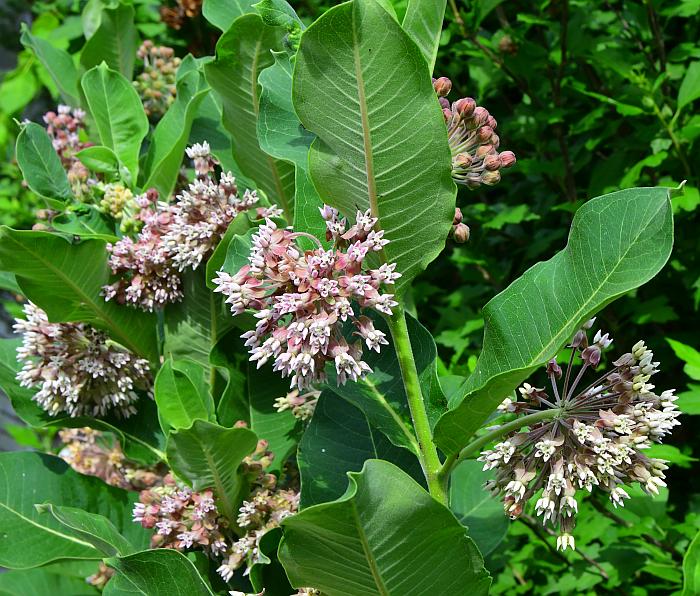Asclepias syriaca L.
Common Milkweed

Native
CC = 0
CW = 3
MOC = 59
© SRTurner
Asclepias syriaca L.Common Milkweed | |
 |
Native CC = 0 CW = 3 MOC = 59 |
© SRTurner |
|
Family - Asclepiadaceae Habit - Perennial forb with deep rhizomes. Stems - Erect, to 2 m, stout, sparsely to densely hairy, with milky sap, usually unbranched below the inflorescence, with 7-15 nodes.
Leaves - Opposite, simple, entire, short-petiolate, usually decussate. Petioles to 1 cm long. Blades to 30 cm long, 11 cm broad, oblong or elliptic-ovate, rounded to truncate at base, rounded or pointed at tip, usually mucronate, densely hairy and light green below, darker green and sparsely hairy above, the midrib often purplish adaxially. Veins of the leaf anistomosing before the margins of the leaf (best viewed abaxially).
Inflorescence - Globose umbels, pedunculate, terminal and axillary located on the apical half of the stem, 2-10 per stem, with 20-100 flowers. Peduncles to 6 cm long, densely hairy. Pedicels densely hairy, to 4 cm long, typically with some purplish tinge.
Flowers - Calyx lobes 5, reflexed, short-hairy, 2.5-4.0 mm long, lanceolate to elliptic-lanceolate. Corolla lobes 5, reflexed, short-hairy on the outer surface and usually also on the inner surface near the base, green to lavender, usually tinged with pink and/or white, 7-10 mm long, elliptic-lanceolate. Gynostegium appearing very short-stalked (the column barely visible below the bases of the hoods), pale pink to pale purple, the corona conspicuously longer than the tip of the anther/stigma head. Corona hoods 3.5-5.0 mm long, whitish-purple, glabrous, spreading to ascending, attached near their bases, gradually narrowed from at or above the middle, the apical portion oblong to ovate in outline, the tip rounded, the margins with a pair of sharply triangular, ascending and incurved lobes at about the middle, the bases not pouched. Horns whitish-purple, attached toward the hood bases, relatively short, bent or curved abruptly inward over the anther/stigma head and not extended past the tips of the hoods, sickle-shaped, relatively stout, slightly flattened, tapered to a sharp point at the tip. Column dark purple and whitish at the apex, 2-3 mm long and broad. Anther sacs 2 mm long, connective dark purplish-brown.
Fruits - Follicles 7-12 cm long, erect or ascending from deflexed stalks, narrowly ovate to ovate and usually noticeably arched in outline, the surface with soft, narrow, warty tubercles, densely woolly. Seeds with the body 6-8 mm long, the margins narrowly winged, the terminal tuft of hairs white to light cream-colored or tan.
Flowering - May - August. Habitat - Fields, prairies, pastures, open woods, roadsides, railroads, waste ground. Origin - Native to the U.S. Lookalikes - A. sullivantii, which is far less common in Missouri. Other info. - This robust species can be found throughout most of Missouri, as well as the upper Midwest, New England, and Canada. It is arguably the most common milkweed throughout the region and is a common sight along many roadsides. It is easily recognizable, though similar in appearance to the much less common A. sullivantii, a species which lacks the dense hairiness of the common milkweed. Another similar species, A. purpurescens, has flowers more deeply purple in color, inflorescences which are at the apex of the plant, and fruits which are smooth rather than warty.
Photographs taken off Hwy 106, Shannon County, MO., 6-10-04 (DETenaglia); also at Weldon Spring Conservation Area, St. Charles County, MO, 9-1-2007; near Labadie, Franklin County, MO, 6-22-2014 and 6-22-2023; and Whetstone Conservation Area, Callaway County, MO, 7-15-2016 (SRTurner). |